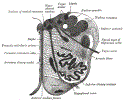II. Anatomy: Superior (Rostral) Medulla Components
- Fourth Ventricle
- Nucleii (organized in anterior-to-posterior bands)
- Somatic Motor Nucleii (most medial)
- CN 12: Hypoglossal Nerve (motor, Tongue)
- Somatovisceral nerves (Branchiomeric Nerves)
- Nucleus Ambiguous (CN 9, CN 10, swallow)
- Visceral Motor Nucleii
- CN 9: Glossopharyngeal Nerve (Inferior Salivatory nucleus)
- CN 10: Vagus Nerve (Dorsal motor nucleus )
- Visceral Sensory Nucleii
- Somatic Sensory Nucleii (most lateral)
- Somatic Motor Nucleii (most medial)
-
Spinothalamic Tract
- Continued pain and TemperatureSensation tracts from the spinal cord
-
Spinocerebellar Tract
- Continued tracts for transmitting UNCONSCIOUS proprioception Sensation (e.g. walking)
- Remains ipsilateral as it courses to the Cerebellum via the superior and inferior peduncles
-
Medial Lemniscus
- Proprioception Sensation from Posterior Columns (via Internal Arcuate Tract)
- Within the tract, head is represented posteriorly and legs anteriorly (as if standing on the pyramids)
- Inferior Olivary Nucleus (inferior olive)
- Coordination of specialized task related movement (via Cerebellum)
- Anterior pyramids
- Corticospinal tract
- Continued motor tracts to the spinal cord
- Corticospinal tract
III. Anatomy: Inferior (Caudal) Medulla Components
- Nucleii for Posterior Columns or dorsal columns (sensory, posterior cord)
- Transmits CONSCIOUS proprioception, vibratory Sensation and stereognosis (and partially light touch)
- Sensory signals rise within the spinal cord from Fasciculus Gracilis and Fasciculus Cuneatus
- Synapse at the Nucleus Gracilis and Nucleus Cuneatus in Medulla to form Internal Arcuate Tract
- Internal Arcuate Tract crosses over the midline at the Medulla to form Medial Lemniscus
- Medial Lemniscus courses to contralateral Thalamus and cerebral cortex
- Nucleus Gracilis
- Transmits proprioception sensory signals from the lower part of the body
- Nucleus Cuneatus
- Transmits proprioception sensory signals from the upper part of the body
- Transmits CONSCIOUS proprioception, vibratory Sensation and stereognosis (and partially light touch)
- Somatic Sensory Nucleii (most lateral)
-
Spinothalamic Tract
- Continued pain and TemperatureSensation tracts from the spinal cord
-
Spinocerebellar Tract
- Continued tracts for transmitting UNCONSCIOUS proprioception Sensation (e.g. walking)
- Remains ipsilateral as it courses to the Cerebellum via the superior and inferior peduncles
- Crossings (Decussations)
- Medial Lemniscus (from Posterior Columns via Internal Arcuate Tract) Decussation
- Corticospinal tract Decussation
IV. Anatomy: Vascular
-
Anterior Spinal Artery
- Supplies midline Medulla
-
Vertebral Artery
- Supplies Medulla between Anterior Spinal Artery and PICA
-
Posterior Inferior Cerebellar Artery (PICA)
- Supplies posterolateral Medulla
V. Anatomy: Images
- Rostral (superior cross-section)
- Caudal (inferior cross-section)
- Other images
 Lewis (1918) Gray's Anatomy 20th ed (in public domain at Yahoo or BartleBy)
Lewis (1918) Gray's Anatomy 20th ed (in public domain at Yahoo or BartleBy) Lewis (1918) Gray's Anatomy 20th ed (in public domain at Yahoo or BartleBy)
Lewis (1918) Gray's Anatomy 20th ed (in public domain at Yahoo or BartleBy)
VI. References
- Gilman (1989) Manter and Gatz Essentials of Neuroanatomy and Neurophysiology, Davis, p. 81-96
- Goldberg (2014) Clinical Neuroanatomy, Medmaster, p. 24-39
- Netter (1997) Atlas Human Anatomy, ICON Learning, p. 108-12


